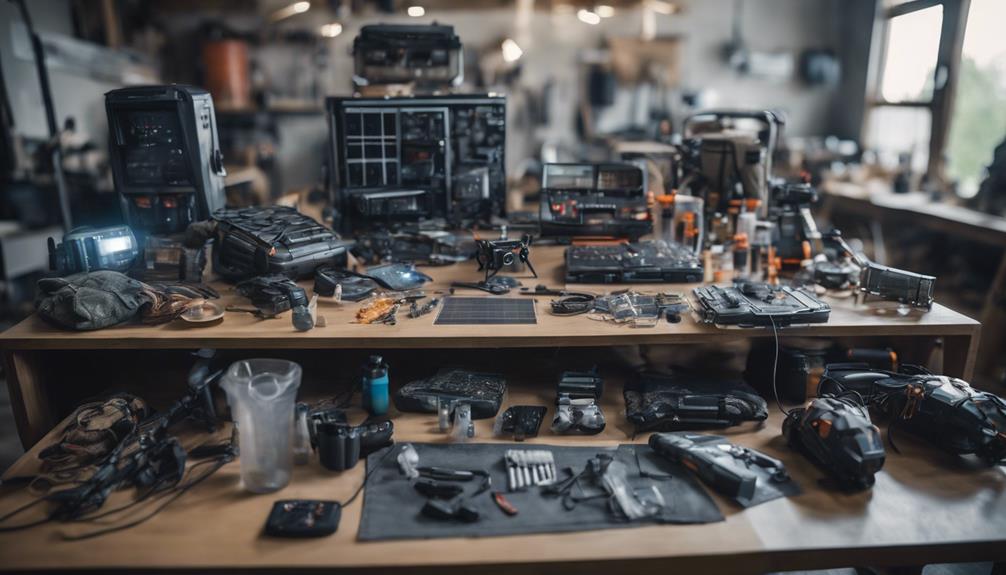Compact firearms are essential for survival enthusiasts, providing the perfect balance of portability and functionality. Options like the Kel-Tec Sub 2K offer a folding design and compatibility with popular magazines, ideal for ease of transport. The Folding Survival Shotgun combines lightweight construction with manageable recoil, making it a practical choice for hunting. For small game, the Chiappa Little Badger features a compact design and quiet operation. The Fold AR presents advanced engineering with impressive accuracy, while the TrailBlazer LifeCard provides unparalleled concealment in a credit card-sized format. Explore these options further to discover what fits your survival needs best.
Key Takeaways
- The Kel-Tec Sub 2K offers a folding design and is compatible with popular magazines, making it ideal for survivalists needing reliability and portability.
- A folding survival shotgun provides a lightweight, compact option for various hunting scenarios, enhancing user control with managed recoil loads.
- The Chiappa Little Badger is a minimalistic, lightweight single-shot rifle perfect for small game hunting, featuring a quiet operation and easy storage.
- The Fold AR combines compactness and rifle capability, with advanced folding mechanisms that facilitate transport while maintaining range and accuracy.
The Kel-Tec Sub 2K
The Kel-Tec Sub 2K is a highly regarded folding rifle available in both 9mm and .40 S&W, known for its compatibility with various magazine types, including Glock and SIG Sauer, making it a versatile choice for survival situations.
Its innovative folding design allows the rifle to compactly reduce its size for easy storage and transport, ideal for those needing to optimize space.
Weighing in at approximately 4.25 pounds, it is lightweight yet effective, making it suitable for users with limited strength.
The Sub 2K excels as a close-range defensive weapon and is an affordable option for survivalists seeking reliability without a significant financial investment.
This combination of features solidifies its reputation among compact firearms.
A Folding Survival Shotgun
Folding survival shotguns offer a versatile solution for hunters and survivalists, combining the ability to efficiently take down various game sizes with a compact design that enhances portability. Their single-shot design simplifies operation, making them an excellent choice for those seeking lightweight, effective firearms.
Key features of folding survival shotguns include:
- Compact Design: Easily fits alongside packs, ideal for travel.
- Lightweight Construction: Reduces fatigue during extended use.
- Polymer Furniture: Provides buoyancy and protects against the elements.
- Managed Recoil Loads: Eases handling, enhancing user control and accuracy.
These attributes make folding shotguns a practical addition to any survival toolkit, ensuring hunters and enthusiasts are equipped for various scenarios.
The Chiappa Little Badger

Offering a lightweight and compact solution for small game hunting and pest control, the Chiappa Little Badger is a single shot rimfire rifle designed for ideal portability and accuracy.
Weighing only 2.9 pounds, this rifle folds conveniently for easy storage and transport, making it an excellent choice for survival enthusiasts.
Available in .17 HMR, .22 Magnum, and .22LR, it provides versatility in ammunition selection.
The rifle's design guarantees minimal noise during operation, allowing for quieter hunting and pest control.
Equipped with peep sights and Picatinny rails, it accommodates optics for enhanced targeting capabilities.
The Fold AR
Innovative engineering defines the Fold AR, a firearm that combines compactness with the capability to fire rifle rounds, making it an attractive option for survivalists seeking both portability and power.
This firearm features advanced designs that enhance its usability in various situations, particularly for those who prioritize space without sacrificing performance. It boasts a compact frame, making it ideal for discreet carry or storage in tight spaces. Despite its smaller size, the firearm maintains impressive accuracy and durability, ensuring reliable performance in various environments. Additionally, its versatility makes it a great fit for an affordable gun range setup, allowing users to train effectively without breaking the bank.
Key attributes include:
- Rear Folding Adapter: Allows the firearm to fold neatly, optimizing storage.
- Barrel Folding Mechanism: Further reduces the overall length for transport.
- Rifle Round Capability: Delivers range and accuracy, essential for survival scenarios.
- High-End Engineering: Represents a premium investment for serious enthusiasts.
The TrailBlazer LifeCard

The TrailBlazer LifeCard is a compact .22 LR handgun designed for deep concealment, folding down to the size of a credit card for effortless portability. This unique firearm is primarily intended for survival situations, allowing users to carry a discreet option for small game hunting or personal defense. While its single-shot capacity limits functionality, its innovative design appeals to those prioritizing concealment.
| Feature | Description | Purpose |
|---|---|---|
| Folding Design | Folds to credit card size | Deep concealment |
| Caliber | .22 LR | Small game hunting |
| Weight | Lightweight and portable | Easy transport |
Despite its high price point, the LifeCard remains a notable choice for those seeking a compact, reliable firearm.
Frequently Asked Questions
What Are the Legal Requirements for Owning Folding Firearms?
Legal requirements for owning folding firearms vary by jurisdiction, typically involving age restrictions, background checks, and registration. It is crucial to consult local laws and regulations to guarantee compliance before purchasing a folding firearm.
How Do I Maintain and Clean Folding Guns?
To maintain and clean folding guns, disassemble according to the manufacturer's guidelines, use appropriate cleaning solvents and tools, inspect for wear, lubricate moving parts, and guarantee proper reassembly for best performance and longevity.
Are Folding Guns Suitable for Home Defense?
Folding guns can be suitable for home defense due to their compact design, allowing for easy storage and accessibility. However, their effectiveness depends on the user's proficiency and the specific scenario faced in a defensive situation.
What Accessories Are Recommended for Folding Firearms?
When considering accessories for folding firearms, essential items include tactical slings for easier carrying, optics for enhanced accuracy, and magazine pouches for efficient reloads, ensuring ideal performance and usability in various scenarios.
How Do Folding Guns Compare to Traditional Firearms in Performance?
Folding guns often prioritize portability and compactness over raw performance compared to traditional firearms. While they excel in convenience and storage, they may have limitations in accuracy, recoil management, and magazine capacity, affecting overall effectiveness.
Conclusion
The increasing popularity of compact firearms among survival enthusiasts illustrates a growing recognition of the importance of adaptability and portability in emergency situations.
Significantly, studies indicate that approximately 60% of outdoor enthusiasts prioritize lightweight and compact gear when preparing for survival scenarios.
This trend underscores the necessity for firearms that not only meet diverse functional requirements but also enhance mobility.
As survival situations can be unpredictable, the evolution of compact firearms plays a vital role in ensuring preparedness and resilience.










